2013 JEEP GRAND CHEROKEE height
[x] Cancel search: heightPage 89 of 661
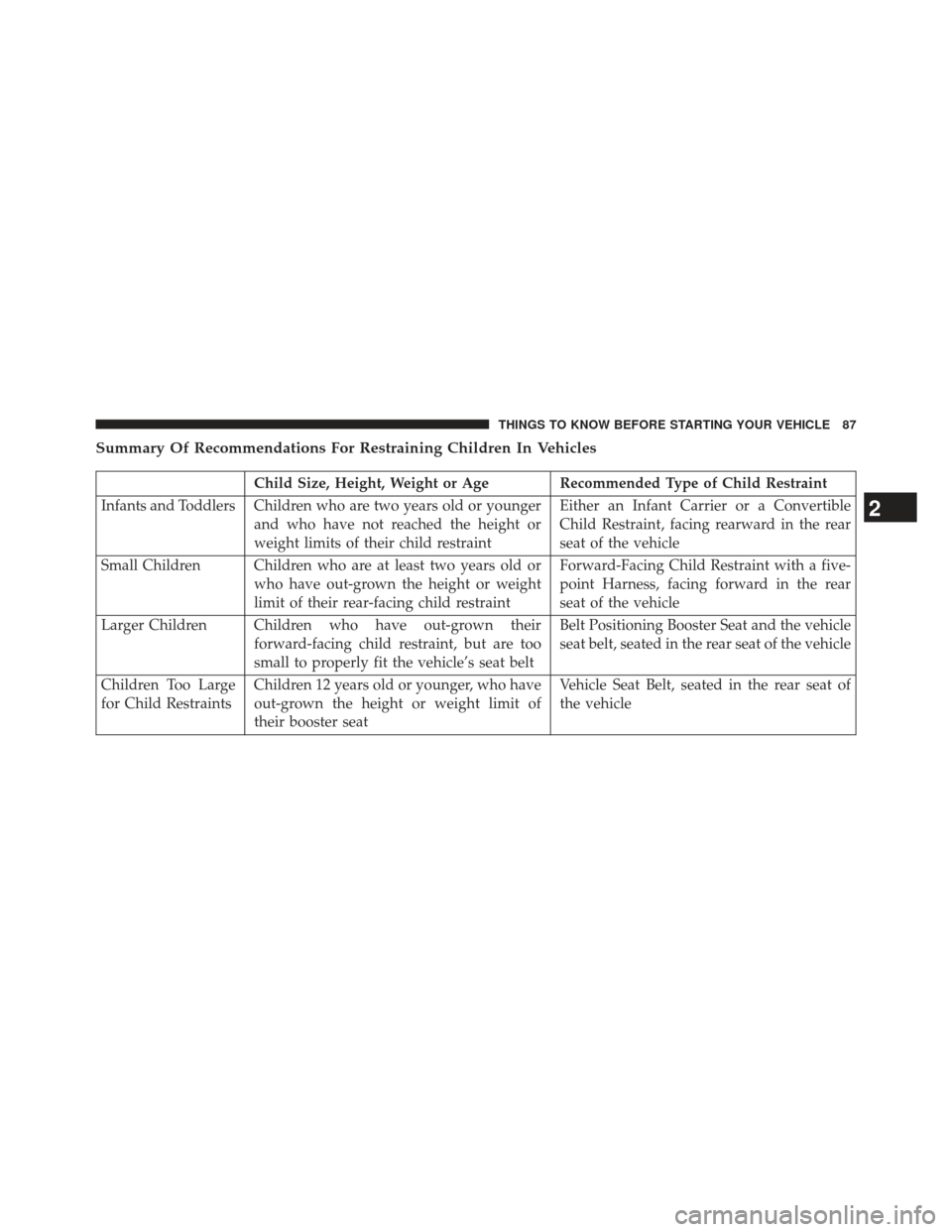
Summary Of Recommendations For Restraining Children In Vehicles
Child Size, Height, Weight or Age Recommended Type of Child Restraint
Infants and Toddlers Children who are two years old or younger and who have not reached the height or
weight limits of their child restraint Either an Infant Carrier or a Convertible
Child Restraint, facing rearward in the rear
seat of the vehicle
Small Children Children who are at least two years old or who have out-grown the height or weight
limit of their rear-facing child restraint Forward-Facing Child Restraint with a five-
point Harness, facing forward in the rear
seat of the vehicle
Larger Children Children who have out-grown their forward-facing child restraint, but are too
small to properly fit the vehicle’s seat belt Belt Positioning Booster Seat and the vehicle
seat belt, seated in the rear seat of the vehicle
Children Too Large
for Child Restraints Children 12 years old or younger, who have
out-grown the height or weight limit of
their booster seat Vehicle Seat Belt, seated in the rear seat of
the vehicle
2
THINGS TO KNOW BEFORE STARTING YOUR VEHICLE 87
Page 90 of 661
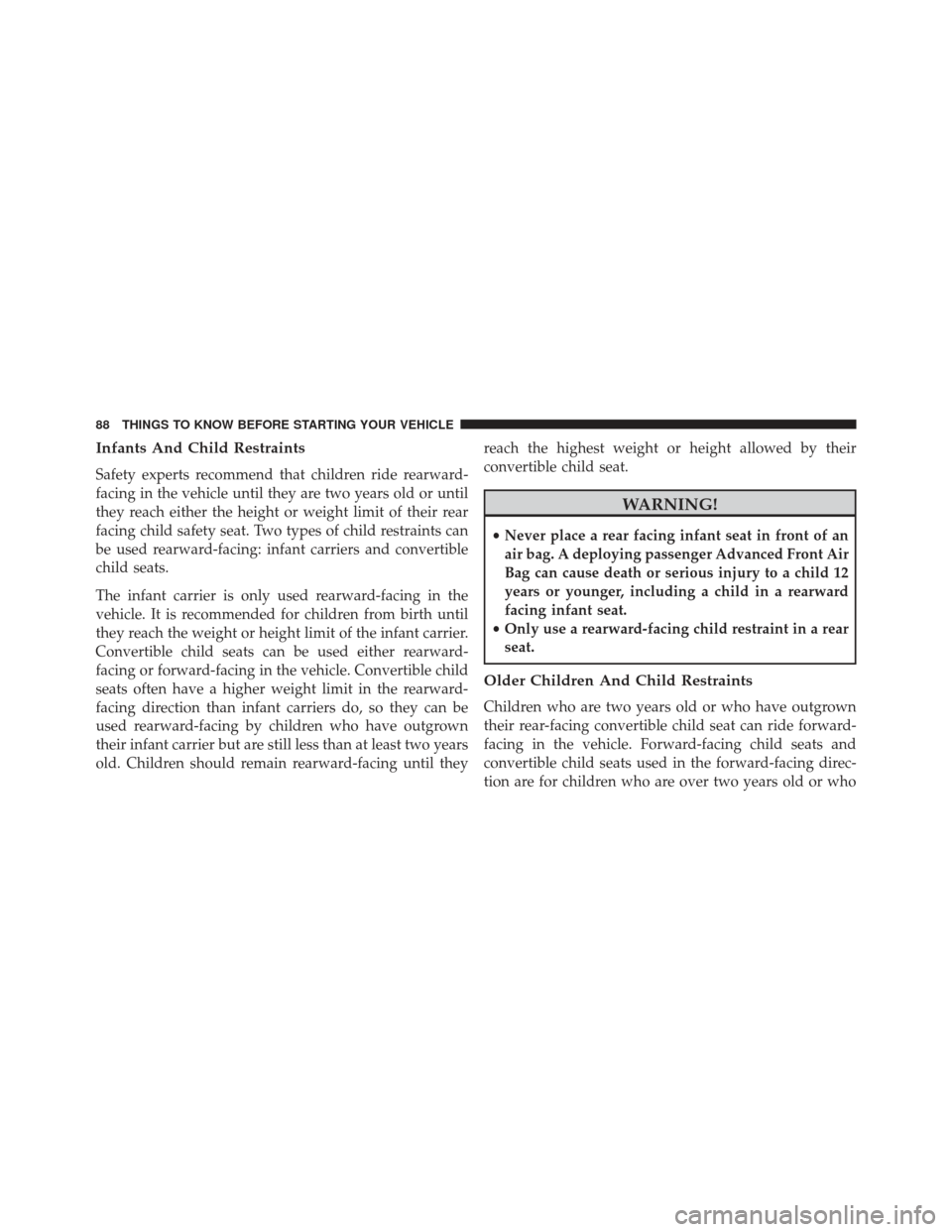
Infants And Child Restraints
Safety experts recommend that children ride rearward-
facing in the vehicle until they are two years old or until
they reach either the height or weight limit of their rear
facing child safety seat. Two types of child restraints can
be used rearward-facing: infant carriers and convertible
child seats.
The infant carrier is only used rearward-facing in the
vehicle. It is recommended for children from birth until
they reach the weight or height limit of the infant carrier.
Convertible child seats can be used either rearward-
facing or forward-facing in the vehicle. Convertible child
seats often have a higher weight limit in the rearward-
facing direction than infant carriers do, so they can be
used rearward-facing by children who have outgrown
their infant carrier but are still less than at least two years
old. Children should remain rearward-facing until theyreach the highest weight or height allowed by their
convertible child seat.
WARNING!
•
Never place a rear facing infant seat in front of an
air bag. A deploying passenger Advanced Front Air
Bag can cause death or serious injury to a child 12
years or younger, including a child in a rearward
facing infant seat.
• Only use a rearward-facing child restraint in a rear
seat.
Older Children And Child Restraints
Children who are two years old or who have outgrown
their rear-facing convertible child seat can ride forward-
facing in the vehicle. Forward-facing child seats and
convertible child seats used in the forward-facing direc-
tion are for children who are over two years old or who
88 THINGS TO KNOW BEFORE STARTING YOUR VEHICLE
Page 91 of 661
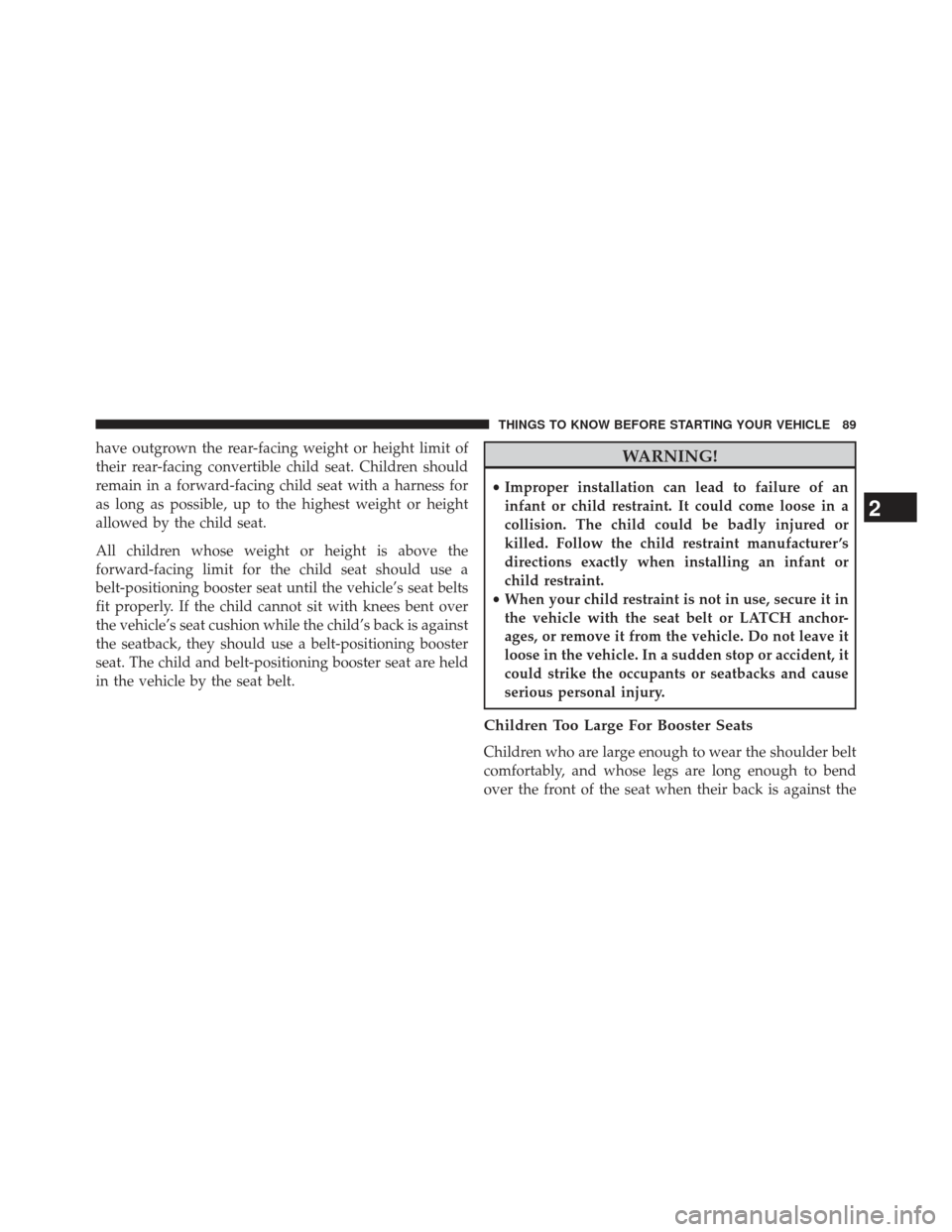
have outgrown the rear-facing weight or height limit of
their rear-facing convertible child seat. Children should
remain in a forward-facing child seat with a harness for
as long as possible, up to the highest weight or height
allowed by the child seat.
All children whose weight or height is above the
forward-facing limit for the child seat should use a
belt-positioning booster seat until the vehicle’s seat belts
fit properly. If the child cannot sit with knees bent over
the vehicle’s seat cushion while the child’s back is against
the seatback, they should use a belt-positioning booster
seat. The child and belt-positioning booster seat are held
in the vehicle by the seat belt.WARNING!
•Improper installation can lead to failure of an
infant or child restraint. It could come loose in a
collision. The child could be badly injured or
killed. Follow the child restraint manufacturer ’s
directions exactly when installing an infant or
child restraint.
• When your child restraint is not in use, secure it in
the vehicle with the seat belt or LATCH anchor-
ages, or remove it from the vehicle. Do not leave it
loose in the vehicle. In a sudden stop or accident, it
could strike the occupants or seatbacks and cause
serious personal injury.
Children Too Large For Booster Seats
Children who are large enough to wear the shoulder belt
comfortably, and whose legs are long enough to bend
over the front of the seat when their back is against the
2
THINGS TO KNOW BEFORE STARTING YOUR VEHICLE 89
Page 179 of 661
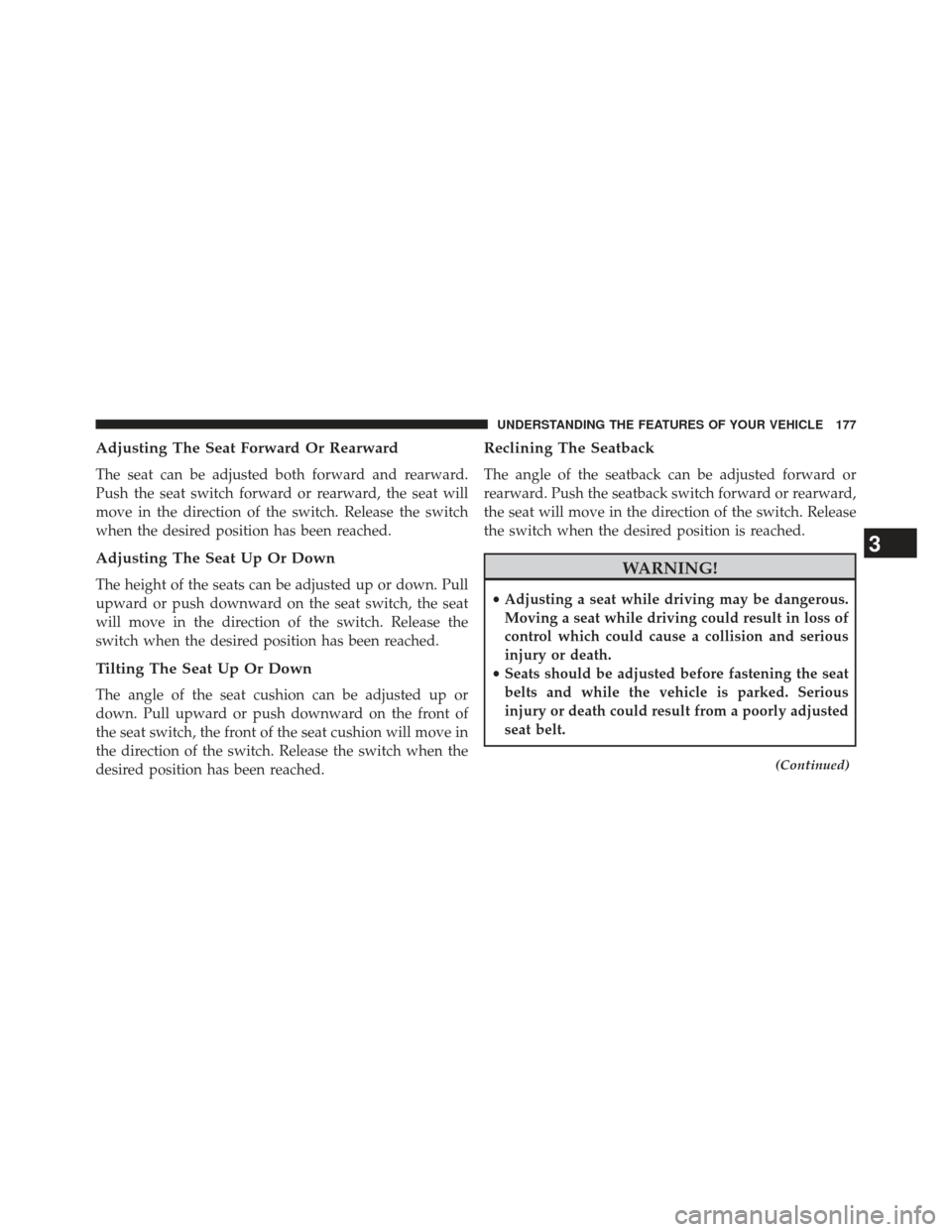
Adjusting The Seat Forward Or Rearward
The seat can be adjusted both forward and rearward.
Push the seat switch forward or rearward, the seat will
move in the direction of the switch. Release the switch
when the desired position has been reached.
Adjusting The Seat Up Or Down
The height of the seats can be adjusted up or down. Pull
upward or push downward on the seat switch, the seat
will move in the direction of the switch. Release the
switch when the desired position has been reached.
Tilting The Seat Up Or Down
The angle of the seat cushion can be adjusted up or
down. Pull upward or push downward on the front of
the seat switch, the front of the seat cushion will move in
the direction of the switch. Release the switch when the
desired position has been reached.
Reclining The Seatback
The angle of the seatback can be adjusted forward or
rearward. Push the seatback switch forward or rearward,
the seat will move in the direction of the switch. Release
the switch when the desired position is reached.
WARNING!
•Adjusting a seat while driving may be dangerous.
Moving a seat while driving could result in loss of
control which could cause a collision and serious
injury or death.
• Seats should be adjusted before fastening the seat
belts and while the vehicle is parked. Serious
injury or death could result from a poorly adjusted
seat belt.
(Continued)
3
UNDERSTANDING THE FEATURES OF YOUR VEHICLE 177
Page 180 of 661
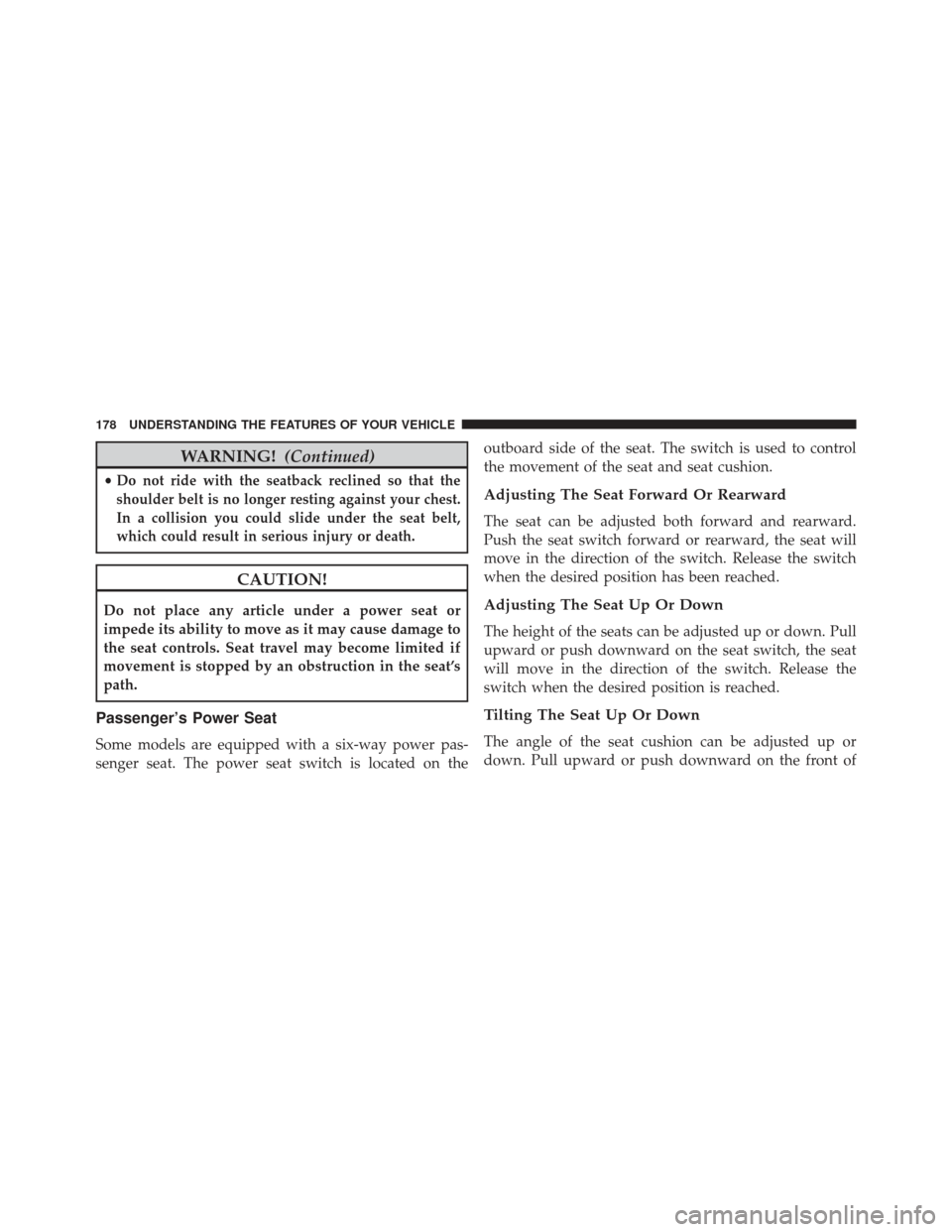
WARNING!(Continued)
•Do not ride with the seatback reclined so that the
shoulder belt is no longer resting against your chest.
In a collision you could slide under the seat belt,
which could result in serious injury or death.
CAUTION!
Do not place any article under a power seat or
impede its ability to move as it may cause damage to
the seat controls. Seat travel may become limited if
movement is stopped by an obstruction in the seat’s
path.
Passenger’s Power Seat
Some models are equipped with a six-way power pas-
senger seat. The power seat switch is located on the outboard side of the seat. The switch is used to control
the movement of the seat and seat cushion.
Adjusting The Seat Forward Or Rearward
The seat can be adjusted both forward and rearward.
Push the seat switch forward or rearward, the seat will
move in the direction of the switch. Release the switch
when the desired position has been reached.
Adjusting The Seat Up Or Down
The height of the seats can be adjusted up or down. Pull
upward or push downward on the seat switch, the seat
will move in the direction of the switch. Release the
switch when the desired position is reached.
Tilting The Seat Up Or Down
The angle of the seat cushion can be adjusted up or
down. Pull upward or push downward on the front of
178 UNDERSTANDING THE FEATURES OF YOUR VEHICLE
Page 207 of 661

Automatic Headlight Leveling — HID Headlights
Only
This feature prevents the headlights from interfering
with the vision of oncoming drivers. Headlight leveling
automatically adjusts the height of the headlight beam in
reaction to changes in vehicle pitch.
Headlight Delay
To aid in your exit, your vehicle is equipped with a
headlight delay that will leave the headlights on for
approximately 90 seconds. This delay is initiated when
the ignition is turned OFF while the headlight switch is
on, and then the headlight switch is cycled off. Headlight
delay can be cancelled by either turning the headlight
switch on then off, or by turning the ignition ON.The headlight delay time is programmable on vehicles
equipped with an Electronic Vehicle Information Center
(EVIC). Refer to “Electronic Vehicle Information Center
(EVIC)/Customer-Programmable Features” in “Under-
standing Your Instrument Panel” for further information.
Parking Lights And Panel Lights
To turn on the parking lights and instrument
panel lights, rotate the headlight switch clockwise.
To turn off the parking lights, rotate the headlight switch
back to the O (Off) position.
3
UNDERSTANDING THE FEATURES OF YOUR VEHICLE 205
Page 335 of 661
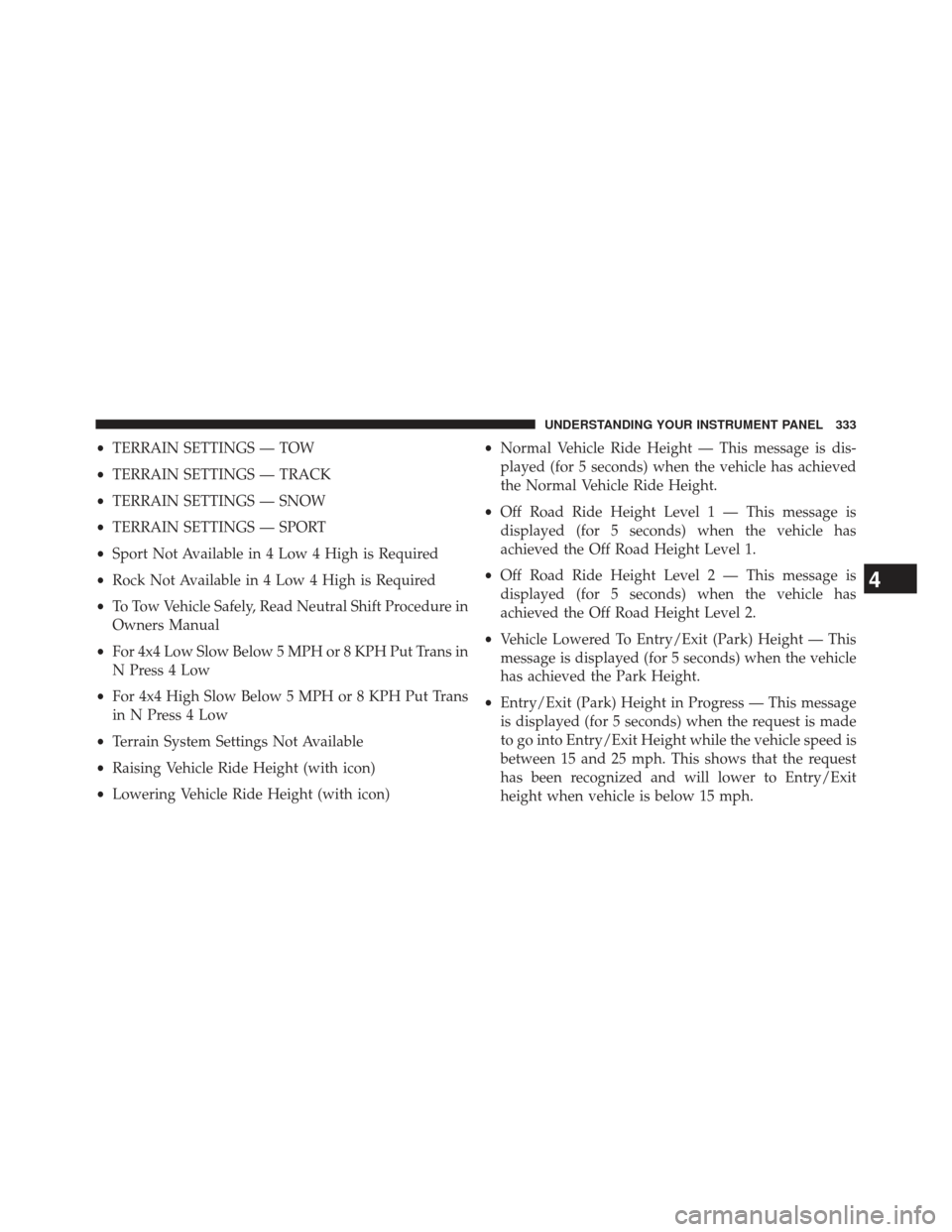
•TERRAIN SETTINGS — TOW
• TERRAIN SETTINGS — TRACK
• TERRAIN SETTINGS — SNOW
• TERRAIN SETTINGS — SPORT
• Sport Not Available in 4 Low 4 High is Required
• Rock Not Available in 4 Low 4 High is Required
• To Tow Vehicle Safely, Read Neutral Shift Procedure in
Owners Manual
• For 4x4 Low Slow Below 5 MPH or 8 KPH Put Trans in
N Press 4 Low
• For 4x4 High Slow Below 5 MPH or 8 KPH Put Trans
in N Press 4 Low
• Terrain System Settings Not Available
• Raising Vehicle Ride Height (with icon)
• Lowering Vehicle Ride Height (with icon) •
Normal Vehicle Ride Height — This message is dis-
played (for 5 seconds) when the vehicle has achieved
the Normal Vehicle Ride Height.
• Off Road Ride Height Level 1 — This message is
displayed (for 5 seconds) when the vehicle has
achieved the Off Road Height Level 1.
• Off Road Ride Height Level 2 — This message is
displayed (for 5 seconds) when the vehicle has
achieved the Off Road Height Level 2.
• Vehicle Lowered To Entry/Exit (Park) Height — This
message is displayed (for 5 seconds) when the vehicle
has achieved the Park Height.
• Entry/Exit (Park) Height in Progress — This message
is displayed (for 5 seconds) when the request is made
to go into Entry/Exit Height while the vehicle speed is
between 15 and 25 mph. This shows that the request
has been recognized and will lower to Entry/Exit
height when vehicle is below 15 mph.
4
UNDERSTANDING YOUR INSTRUMENT PANEL 333
Page 336 of 661
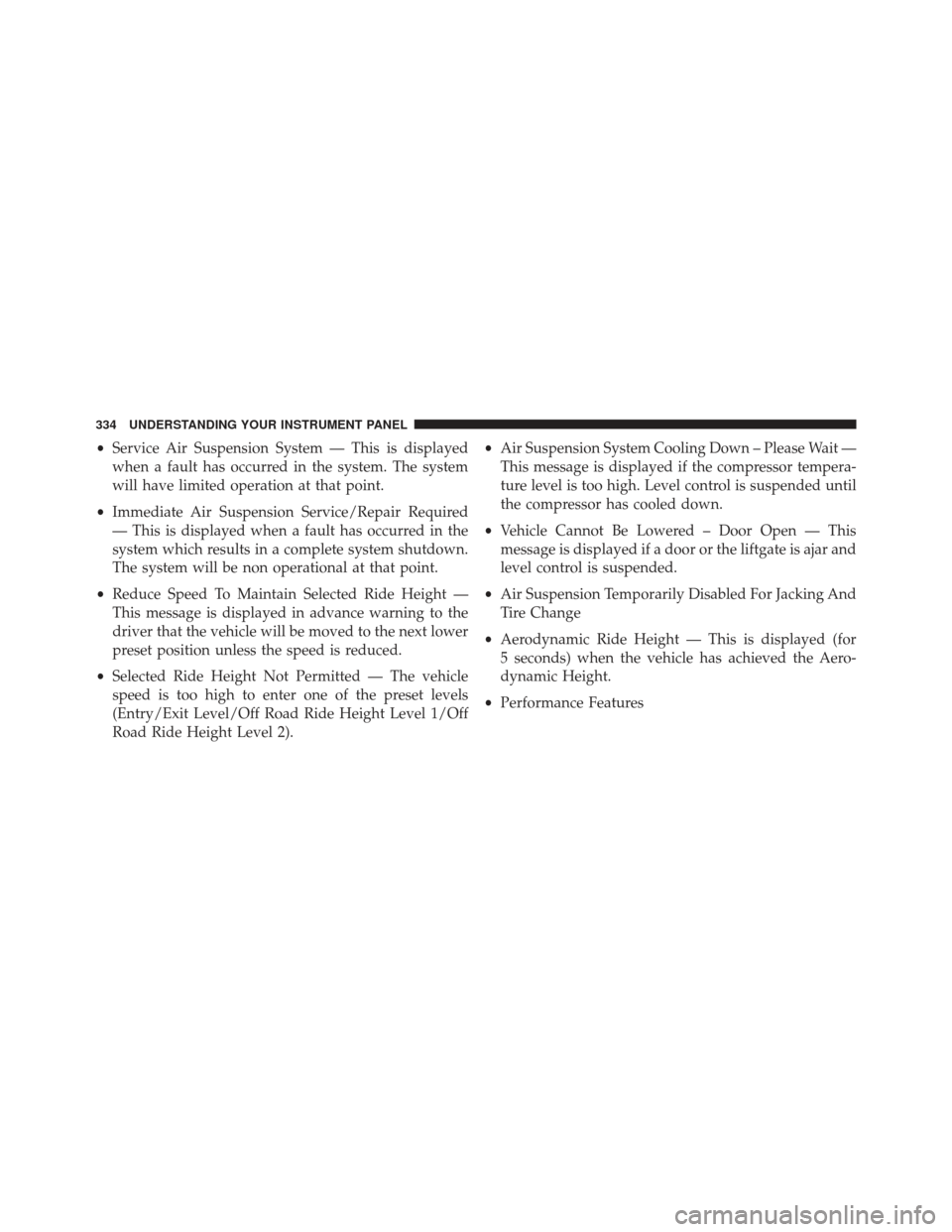
•Service Air Suspension System — This is displayed
when a fault has occurred in the system. The system
will have limited operation at that point.
• Immediate Air Suspension Service/Repair Required
— This is displayed when a fault has occurred in the
system which results in a complete system shutdown.
The system will be non operational at that point.
• Reduce Speed To Maintain Selected Ride Height —
This message is displayed in advance warning to the
driver that the vehicle will be moved to the next lower
preset position unless the speed is reduced.
• Selected Ride Height Not Permitted — The vehicle
speed is too high to enter one of the preset levels
(Entry/Exit Level/Off Road Ride Height Level 1/Off
Road Ride Height Level 2). •
Air Suspension System Cooling Down – Please Wait —
This message is displayed if the compressor tempera-
ture level is too high. Level control is suspended until
the compressor has cooled down.
• Vehicle Cannot Be Lowered – Door Open — This
message is displayed if a door or the liftgate is ajar and
level control is suspended.
• Air Suspension Temporarily Disabled For Jacking And
Tire Change
• Aerodynamic Ride Height — This is displayed (for
5 seconds) when the vehicle has achieved the Aero-
dynamic Height.
• Performance Features
334 UNDERSTANDING YOUR INSTRUMENT PANEL